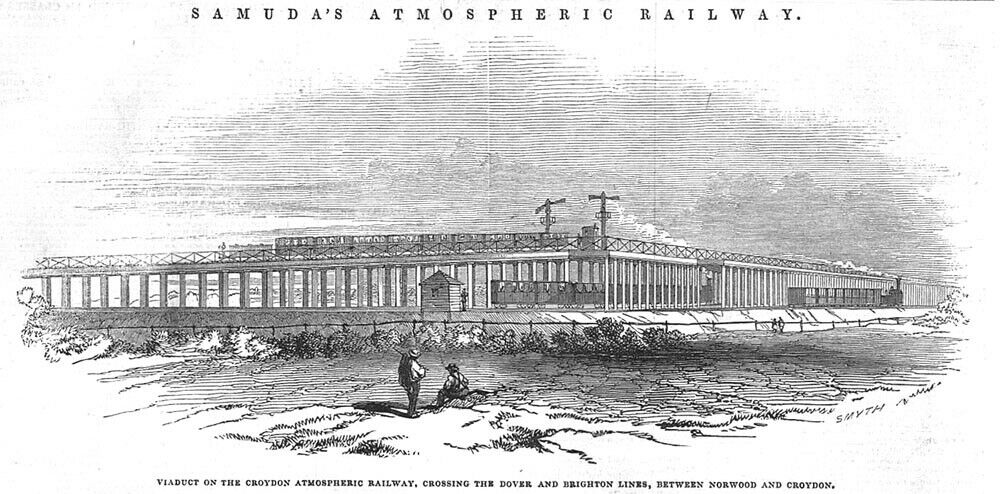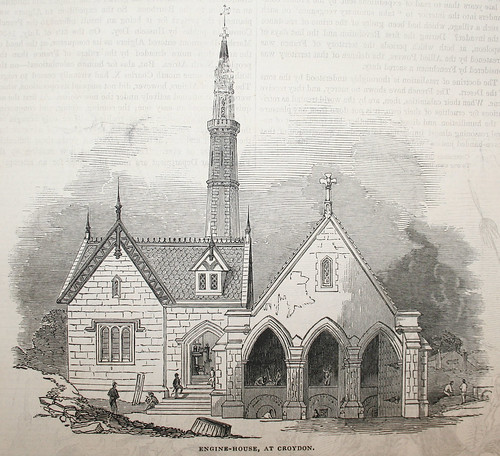
1845
St. Leonards 1845-c1994
St Leonards was also known as Hastings was opened in November 1845, by the L.B.S.C.R.
(Shed Codes from 1845 was H until 1903 and from 1903 onwards it was StL.).
With the formation of the Southern Railway the locomotive shed transferred from being a sub shed of Brighton and become a sub shed of Ashford, were it adopted a British Railway shed code of 74E (1950 - 1958) and later a sub shed of Stewarts Lane/Hither Green 73D (1963 - 1973) and in 1973 SE.
Railway accident on the
London & Croydon Railway
New Cross on 21st June 1845
Railway accident on the
London & Brighton Railway
from http://www.railwaysarchive.co.uk
Clayton Tunnel on 8th September 1845
involving Brighton driver James Carter SEE SUB PAGE
LONDON & CROYDON RAILWAY
ATMOSPHERIC RAILWAY
1845 - 1847
Jolly sailor railway station & pumping station, 1845
In 1845 an atmospheric railway was installed between (West) Croydon and Dartmouth Arms (Forest Hill). It used the method of atmospheric traction invented by gas engineer Samuel Clegg and the marine engineers Jacob and Joseph Samuda.
A large pipe was laid between the existing railway tracks. Three stationary engines positioned at Croydon (West), Jolly Sailor (Norwood Junction) and Dartmouth Road (Forest Hill) worked large air pumps which sucked the air out of the pipe in front of the train. The pump houses communicated with each other using Cooke & Wheatstone’s two-needle electric telegraph.

At the Jolly Sailor needed to cross the London & Brighton Railway line. The atmospheric pipe made this impossible on the flat, and a flyover was constructed to enable the crossing: this was the first example in the railway world.
Each train was headed by a special carriage which had an arm underneath which passed through a slot into the pipe. A piston was attached to the leading edge of the arm and a counterweight to the rear. The slot in the pipe was closed by a valve, formed of a leather strap covered with short plates of iron above and below. Wheels on the leading edge of the piston arm raised the valve, allowing the piston to move along the pipe. Air rushed in through this gap directly onto the back of the piston. The valve then fell back into place behind the piston arm and a wheel attached to one of the carriages pressed it down. On the opening side of the valve was a groove which was filled with a mixture of wax and tallow. A heated copper bar was then drawn along the groove to force this mixture against the edge of the valve and so form an airtight seal. The vacuum in front of the piston and atmospheric pressure behind it caused the train to move forward.
The advantages of the atmospheric system were that it didn’t need smelly, noisy and dirty locomotives to haul the carriages; it was considered safer - as two trains could not work simultaneously between two pumping stations there was no risk of collisions; and it was expected to be much cheaper to run.
The atmospheric railway called at Croydon (now West Croydon), Jolly Sailor (Norwood Junction), Annerley (now spelt Anerley), Penge (Penge West), Sydenham and Dartmouth Arms (Forest Hill) stations. This route was flat except for a wooden fly-over at Brighton Junction near Jolly Sailor (the first fly-over in the world). This was necessary because the atmospheric pipe couldn’t cross other lines on the same level.
The first trial was on 22nd August 1845. The train reached 60mph on that occasion and on a later trial achieved 70mph. However, failures occurred with the pumping equipment and the public opening was delayed until 19th January 1846. By December 1846 the atmospheric railway had been extended from Dartmouth Arms to New Cross, but the system was abandoned on the 4th May 1847 and the line changed over to locomotives.
There had been constant problems in maintaining the air-tight seals that were necessary to create the vacuum. In warm weather the mixture used to seal the valve melted and the leather hardened. In cold weather the leather cracked. Rubbish, including rats, were sucked through the pipes and clogged up the air valves. There were also delays in turnaround times at each end of the track. The piston carriage could not reverse and neither could the iron pipe cross other rails. So to get the piston carriage to the other end of the train it had to be manhandled out of the tube, have its piston and counter weight removed, then be taken round its train by further manhandling or possibly horse towing, have the piston and counterweight replaced the opposite way round and then re-inserted in the tube. The final straw was that, far from being cheaper, the power for the trains actually cost about three times more than conventional engines.
Opening of the Brighton to
Worthing Railway Line 1845
On Monday, the 24th November 1845 saw the opening of the extension of the Brighton to
Shoreham line to Worthing. The first three trains from Brighton to Worthing and the first two trains from Worthing to Brighton operated without problems, but the third returning train from Worthing met with an accident just to the East of Lancing station, at 12.55 p.m. Three horses belonging to a contractor were pulling a train of earth wagons on a temporary line when the lead horse strayed onto the permanent line just when the train was approaching.
The tender was in front of the engine and knocked down the horse before capsizing, falling
onto the horse and killing one and lamed the other two. The engine also capsized but
remained on the line.
Luckily the train was still going slow after leaving Lancing station so none of the passengers
were injured and they were only detained for about two hours before they were transferred to another train and conveyed to Brighton. Trains were delayed for the rest of the day while the engine and tender were righted but that didn’t stop a celebration dinner being held at the
Nelson Hotel, Worthing to celebrate the opening of the line. The driver of the horses was
arrested as he hadn’t been holding the bridle of the lead horse and had not had sufficient
control over them.
POSTCARD

